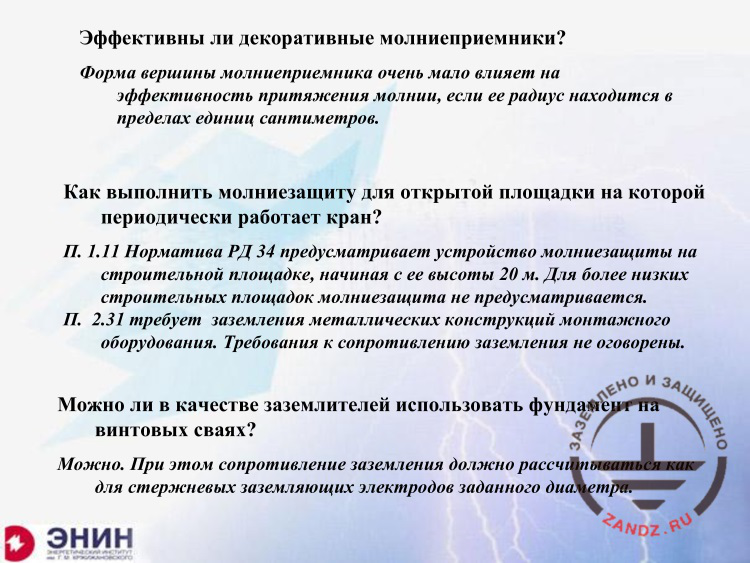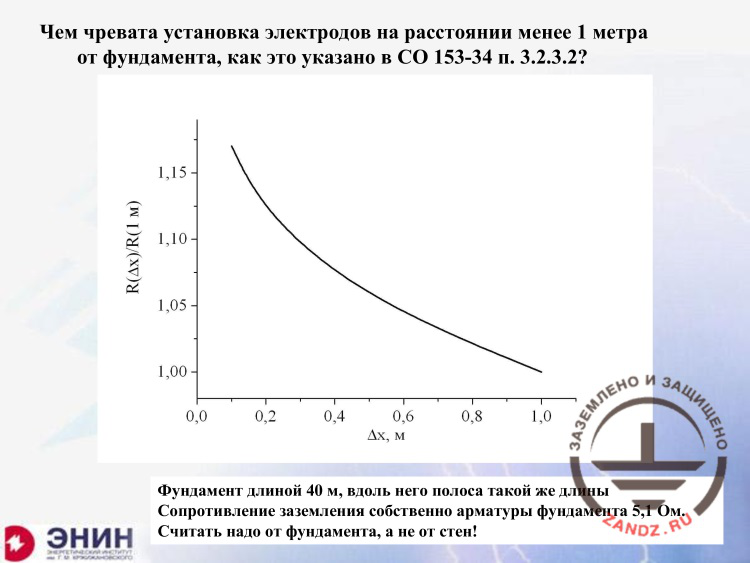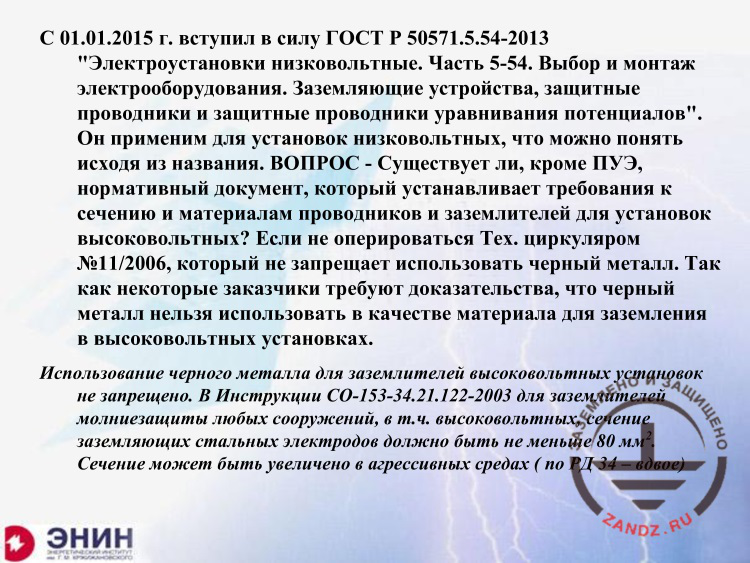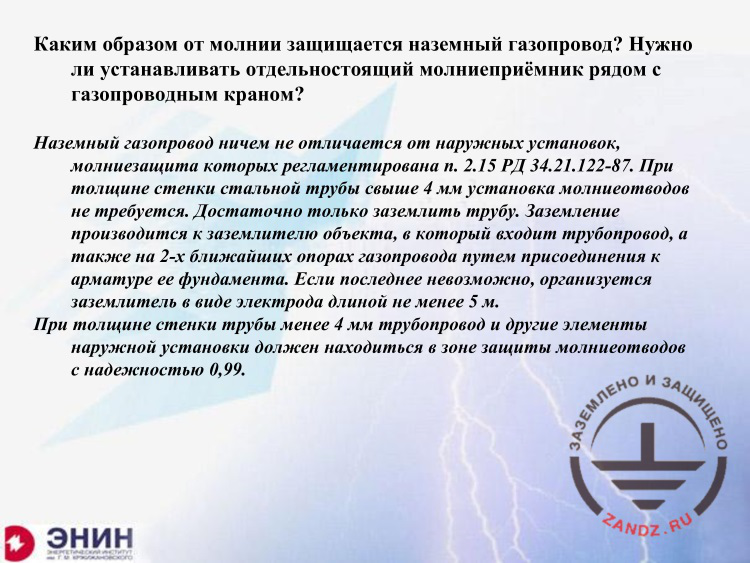The eleventh event of "Earthing and Lightning Protection: Design Issues and Problems" series
Webinar text. Page 3

Are the decorative lightning arresters efficient?
Эффективны ли декоративные молниеприемники?
Форма вершины молниеприемника очень мало влияет на эффективность притяжения молнии, если ее радиус находится в пределах единиц сантиметров.
Как выполнить молниезащиту для открытой площадки, на которой периодически работает кран?
П. 1.11 Норматива РД 34 предусматривает устройство молниезащиты на строительной площадке, начиная с ее высоты 20 м.
Для более низких строительных площадок молниезащита не предусматривается.
П. 2.31 требует заземления металлических конструкций монтажного оборудования.Требования к сопротивлению заземления не оговорены.
Можно ли в качестве заземлителей использовать фундамент на винтовых сваях?
Можно. При этом сопротивление заземления должно рассчитываться как для стержневых заземляющих электродов заданного диаметра.
Are the decorative lightning arresters efficient?
The shape of the lightning arrester’s top does not almost influence the efficiency of the lightning attraction, if its radius is within several centimeters.
How to make the lightning protection for an open area, wherein a crane regularly operates?
Item 1.11 of standard RD 34 stipulates making the lightning protection on the construction site, starting from its height of 20 m.
The lightning protection is not provided for lower construction sites.
Item 2.31 requires earthing of the metal structures of the installation equipment.
Requirements to the earthing resistance are not specified.
Can we use the foundation based on crew piles as the earthing devices?
You can. And the earthing resistance must be calculated as for the earthing rod electrodes of the given diameter.
– Now, I am proceeding to the question that is very easy to answer because you only need to read the regulatory documents for the lightning protection that are effective in Russia. And the first question I receive is as follows. Are the decorative lightning arresters efficient? You know, the point is that there were many efforts taken in the lightning protection to understand how the lightning arrester's configuration affects its protective action. The answer is very simple. If you have used a configuration at which the curve radii of the lightning arrester are within one, two, three centimeters, i.e. within about a centimeter range, then the protective effects of these lightning arresters will be the same as of a typical lightning arrester. Therefore, any decorative lightning arrester, whether it has a cockerel on the roof, or a swallow, or a weathercock on it, its protective effect will be similar. Thus, you can use such decorative lightning arresters. Now, the second question. I think it is a good question. How to make the lightning protection for an open area wherein a crane is regularly operated? Probably you mean a crane truck that moves to the construction site and performs some operations. Here you have to strictly follow the regulatory documents. The only standard that specifies it clearly is RD 34, the old regulatory document. And it states as follows. If you are performing some construction works, and the site during the construction, wherein the construction personnel is located, is elevated to the height of 20 meters, then you must perform a temporary lightning protection for this site that would provide the protection against the direct lightning strikes, which covers the entire territory where the service personnel works. You may not do that if it is lower, but you must do it if it is higher. If your crane has a height of over 20 meters, then the only thing that is required from you is to connect the crane's metal elements to the earthing circuits existing on the construction site. You must not do anything else. By the way, the requirements to the resistance of such earthing device are not generally rated. It means that any earthing device, for example, the already built foundation for this building is suitable for this. That is it. Now, the following question. Can we use a foundation based on crew piles as an earthing device? Frankly, I had to look through the regulatory documents to see what the crew piles are. I read and understood that the situation with them is extremely favorable. We are talking about the hollow metal structures having something like a screw on their base, which is used for making holes in the ice for fishing. Such object is deepened into the soil essentially in a self-propelled manner, and after this their interior space is most often filled with concrete. And the support is thus created. This crew support is a normal element of the earthing circuit. It is made of steel, and it can be used for the earthing circuit. It has a large cross-section, therefore, it can be used for creating an earthing device. And it also has the length of several meters, which is also favorable for creating the earthing device. Thus, if you build a structure foundation using the crew piles, you may use them for earthing, but with one reservation. It is very serious. You have to connect all piles with an earthing bus having the cross-section that matches the requirements specified in our regulatory documents for the current collector. And each of these piles must be combined with all other earthing buses, usually from two sides, i.e. two buses must extend from each pile. One extending to one side, and the other one extending to another side. That is it. The limitations here are as follows. The first limitation that may emerge is: what should we do in case of aggressive soils? Because such crew piles, if they are protected with the bitumen coating, will corrode the way similar to standard carbon steel. And here, the requirements to this pile correspond to the requirements to the use of carbon steel in an earthing device.

What problems are associated with the electrode installation at the distance of less than 1 meter from the foundation as it is specified in SO 153-34, item 3.2.3.2?
Чем чревата установка электродов на расстоянии менее 1 метра от фундамента, как это указано в СО 153-34 п. 3.2.3.2?
Фундамент длиной 40 м, вдоль него полоса такой же длины
Сопротивление заземления собственно арматуры фундамента 5,1 Ом.
Считать надо от фундамента, а не от стен!
What problems are associated with the electrode installation at the distance of less than 1 meter from the foundation as it is specified in SO 153-34, item 3.2.3.2?
Foundation is 40 m long and has a band of the same length around it
The earthing resistance of the foundation reinforcement is 5.1 Ohm.
We should calculate from the foundation but not from the walls!
– This is a very good question. What problems are associated with the electrode installation at the distance of less than 1 meter from the foundation as it is specified in SO 153-34 and so on? Indeed, regulatory document SO-153 states that if your foundation cannot be used as the earthing circuit or if the resistance created by the foundation is too high, then a horizontal earthing circuit that will enclose this foundation along the external perimeter should be laid from the external side of this foundation at the distance of less than one meter from its wall. Such requirement really exists. Before answering this question, I will tell you how the earthing circuit will operate. If you have a foundation, for example, of the building of about 50 meters long and 12 wide, which is a typical residential or administrative building, and you want to create the foundation according to the rules specified in SO 153, then you will reduce its earthing resistance for only about 25 percent, in the best case. It means that its efficiency will be very insignificant. More likely, this foundation and this additional circuit are recommended for another reason. Here is the reason. To avoid getting high potential through the utilities inside the building, these utilities have to be connected to the earthing circuit at the input. If your earthing circuit is the foundation, then you do not have many embedded parts in this foundation, to which you may connect metal pipelines that go inside your building. Sometimes you have to place it to the side for several meters, which is extremely undesirable. And if, in addition to this foundation, you lay a metal bus that will frame it along the external contour, and you may connect the pipelines that go into the foundation to this circuit at any point because this work is very simple. So, if you are talking about this function of the earthing circuit, then you have made it at the distance of one meter or you have made it at the distance of 20 cm; this function will not change. In all cases, all pipes and metal utilities that go into the building will be earthed well.

Do we need any special requirements to the earthing devices in terms of material for the high-voltage units?
С 0101.2015 г. вступил в силу ГОСТ Р 50571.5.54-2013
«Электроустановки низковольтные. Часть 5-54. Выбор и монтаж электрооборудования. Заземляющие устройства, защитные проводники и защитные проводники уравнивания потенциалов»
Он применим для установок низковольтных, что можно понять исходя из названия.
ВОПРОС – Существует ли, кроме ПУЭ, нормативный документ, который устанавливает требования к сечению и материалам проводников и заземлителей для установок высоковольтных?
Если не оперироваться Тех. Циркуляром № 11/2006, который не запрещает использовать черный металл. Так как некоторые заказчики требуют доказательства, что черный металл нельзя использовать в качестве материала для заземления в высоковольтных установках.
Использование черного металла для заземлителей высоковольтных установок не запрещено.
В Инструкции О-153-34.21.122-2003 для заземлителей молниезащиты любых сооружений, в т.ч. высоковольтных, сечение заземляющих стальных электродов должно быть не меньше 80 мм2.
Сечение может быть увеличено в агрессивных средах (по РД 34 – вдвое).
On January 01, 2015, GOST R 50571.5.54-2013 became effective.
“Low-voltage electrical installations. Part 5-54: Selection and erection of electrical equipment. Earthing arrangements, protective conductors and protective bonding conductors”
As the title says, it is applied to the low-voltage units.
QUESTION: Is there any regulatory document in addition to the EIC that sets the requirements for the cross-section and materials of conductors and earthing devices for the high-voltage units?
If you do not use the Technical Bulletin No. 11/2006 that does not prohibit using carbon metal. Since some customers require evidence that carbon metal cannot be used as an earthing material in the high-voltage units.
The use of carbon metal for earthing devices of high-voltage units is allowed.
In Instructions SO-153-34.21.122-2003, for earthing devices of the lightning protection of any structures, including high-voltage units, the cross-section of the earthing steel electrodes should be not less than 80 mm2.
The cross-section may be increased in the aggressive media (according to RD 34, it is 2-fold).
– It is a very long question, but its essence is simple. Do we need any special requirements to the earthing devices in terms of material for the high-voltage units? The requirements to the material for the low-voltage and high-voltage units do not differ in the EIC and the regulatory documents for the lightning protection. To make earthing devices, you can use any materials, except for aluminum, because aluminum corrodes heavily in the earth. If we are talking about carbon steel, about zinc-coated steel, about copper-coated steel, about stainless steel or just about copper, then all of these materials may be equally used in the low- and high-voltage units. If we are talking about the earthing devices for the lightning protection, since we are working on the lightning protection, then steel is allowed for use. And the cross-section of an electrode made of steel that is deepened in the earth should be not less than 80 mm2. There is a reservation that, in aggressive soils, to eliminate the corrosion effects and extend the electrode service life, the desired resistance should be achieved by increasing the cross-section of the steel electrode about 2-fold. For example, RD 34 states up to 160 mm2. There is one more point we should remember. All directions and instructions for the lightning protection contain the position related to the operation of the lightning protection devices. These directions cover the earthing electrodes control, and according to these instruction, we have to annually uncover and check the condition of about 1/6 portion of the earthing device of this facility, such that the condition of electrodes of the entire earthing circuit would be checked once in 6 years. We must not forget about it. And if you use steel electrodes without protective coatings, then you must surely remember this.

How is the onshore gas pipeline protected against lightnings?
Каким образом от молнии защищается наземный газопровод?
Нужно ли устанавливать отдельностоящий молниеприемник рядом с газопроводным краном?
Наземный газопровод ничем не отличается от наружных установок, молниезащита которых регламентирована п. 2.15 РД 34.21.122-87.
При толщине стенки стальной трубы свыше 4 мм установка молниеотводов не требуется.
Достаточно только заземлить трубу.
Заземление производится к заземлителю объекта, в который входит трубопровод, а также на 2-х ближайших опорах газопровода путем присоединения к арматуре ее фундамента.
Если последнее невозможно, организуется заземлитель в виде электрода длиной не менее 5 м.
При толщине стенки трубы менее 4 мм трубопровод и другие элементы наружной установки должен находиться в зоне защиты молниеотводов с надежностью 0,99.
How is the onshore gas pipeline protected against lightnings?
Should we install a standalone lightning arrester near the gas pipeline tap?
An onground gas pipeline does not differ from external units, the lightning protection of which is governed in item 2.1.5 of RD 34.21.122-87.
With the wall thickness of the steel pipe being more than 4 mm, the lightning arrester installation is not required.
Pipe earthing is sufficient.
The earthing is performed to the earthing device of the facility that includes the pipeline, as well as on 2 nearest supports of the gas pipeline through connecting to the reinforcement of its foundation.
If it is impossible, then the earthing device is made as an electrode of 5 m long.
If the pipe wall thickness is less than 4 mm, the pipeline and other elements of the external unit must be within the lightning arresters’ protection zone with a reliability of 0.99.
– How is the onshore gas pipeline protected against lightnings? Should we install a standalone lightning arrester near the gas pipeline tap? We have to answer two of these questions altogether because if you have an onground gas pipeline and an onground gas outlet valve, then all of them according to instruction RD 34 refer to the external installations that require lightning protection if their cross-sections do not permit the direct lightning strike. This is valid for the steel elements, if the thickness of the pipeline wall or the gas outlet valve exceeds 4 mm, then they are absolutely resistant to the lightning and nothing else is required. If the cross-section is less than 4 mm, then you have to protect these installations against the direct lightning strikes. What type of lightning arresters should you use? It is up to you. For the gas pipeline, it will be likely an extended wire lightning arrester; for the gas outlet valve, this lightning arrester may be of a rod-type. Here is the point. The point that relates to the following thing. When will you have an external gas pipeline? You cannot imagine the external gas pipeline that is not dug into the earth and extends for many kilometers. We are talking mostly about the gas pipeline installation at the gas transfer stations, in the tank farms, when the entire territory must be protected. It is clear that the gas pipeline must be located within that territory. If some device is installed at the gas pipeline that releases flammable gases to the atmosphere continuously. It can hardly be like this at the gas pipeline, but it can be in the end element. In this case, in addition to the element itself, the protection zone of the lightning arresters you are installing should also include the zone of flammable gases release, the dimensions of which are set by the fire safety administration depending on the gas pipeline operating mode. Only the constant location of such explosive region above the external element is intended.
Dear colleagues, I think that such form of communication with you is convenient. It may be very positive. It may lead to that you will get answers to your questions in a timely manner and in a suitable form. Therefore, we are waiting for new questions from you. And as for us, we will try to prepare answers as complete as possible. And the completeness of the answer depends heavily on what initial information is contained in the question. It's great if this question is related to a particular facility, to its particular dimensions and to the condition of the soil where the facility is located. We would like to see this in your next questions. Thank you for attention!
<< Previous page
slides from 5 to 8
Related Articles:


 Lightning Protection of Large Territories: Parks, Grounds, Plant Territories. Page 1
Lightning Protection of Large Territories: Parks, Grounds, Plant Territories. Page 1
 Lightning Protection of Large Territories: Parks, Grounds, Plant Territories. Page 2
Lightning Protection of Large Territories: Parks, Grounds, Plant Territories. Page 2
 Lightning Protection of Large Territories: Parks, Grounds, Plant Territories. Page 3
Lightning Protection of Large Territories: Parks, Grounds, Plant Territories. Page 3

